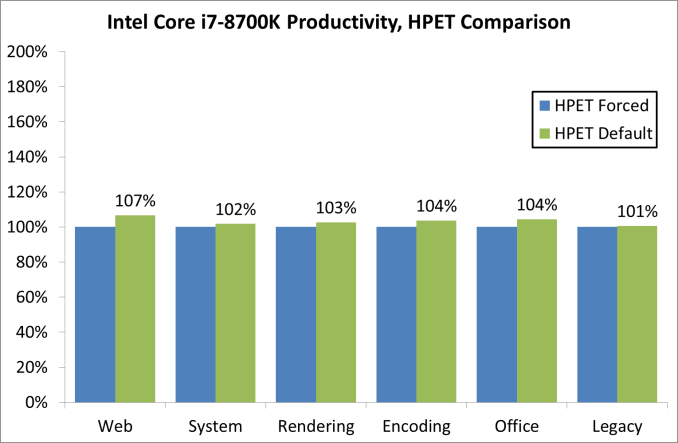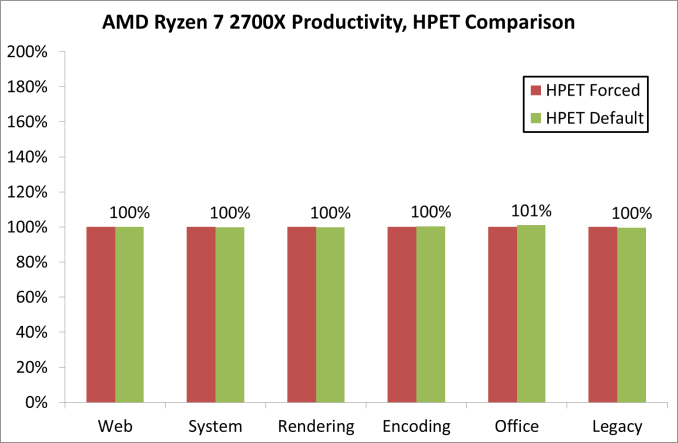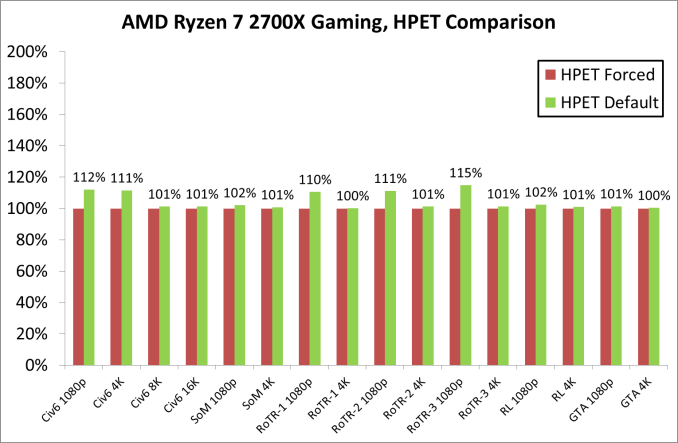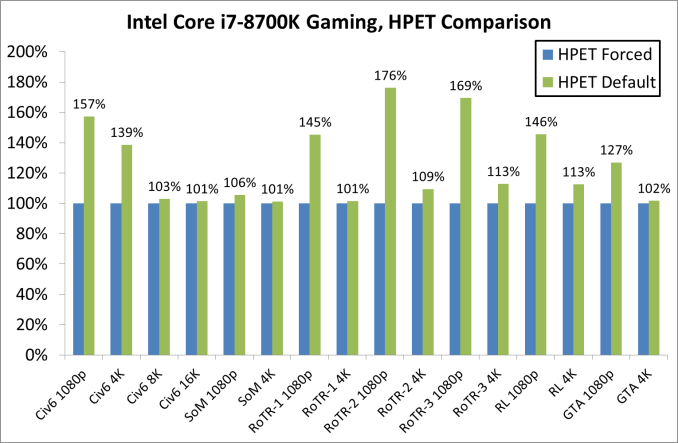A Timely Discovery: Examining Our AMD 2nd Gen Ryzen Results
by Ian Cutress & Ryan Smith on April 25, 2018 11:15 AM ESTForcing HPET On, Plus Spectre and Meltdown Patches
Based on my extreme overclocking roots back in the day, my automated benchmark scripts for the past year or so have forced HPET through the OS. Given that AMD’s guidance is now that it doesn’t matter for performance, and Intel hasn’t even mentioned the issue relating to a CPU review, having HPET enabled was the immediate way to ensure that every benchmark result was consistent, and would not be interfered with by clock drift on special motherboard manufacturer in-OS tweaks. This was a fundamental part of my overclocking roots – if I want to test a CPU, I want to make certainly sure that the motherboard is not causing any issues. It really gets up my nose when after a series of CPU testing, it turns out that the motherboard had an issue – keeping HPET on was designed to stop any timing issues should they arise.
From our results over that time, if HPET was having any effect, it was unnoticed: our results were broadly similar to others, and each of the products fell in line with where they were expected. Over the several review cycles we had, there were a couple of issues that cropped up that we couldn’t explain, such as our Skylake-X gaming numbers that were low, or the first batch of Ryzen gaming tests, where the data was thrown out for being obviously wrong however we never managed to narrow down the issue.
Enter our Ryzen 2000 series numbers in the review last week, and what had changed was the order of results. The way that forcing HPET was affecting results was seemingly adjusted when we bundle in the Spectre and Meltdown patches that also come with their own performance decrease on some systems. Pulling one set of results down further than expected started some alarm bells and needed closer examination.
HPET, by the way it is invoked, is programmed by a memory mapped IO window through the ACPI into the circuit found on the chipset. Accessing it is very much an IO command, and one of the types of commands that fall under the realm of those affected by the Spectre and Meltdown patches. This would imply that any software that required HPET access (or all timing software if HPET is forced) would have the performance reduced even further when these patches are applied, further compounding the issue.
It Affects AMD and Intel Differently: Productivity
So far we have done some quick initial re-testing on the two key processors in this debate, the Ryzen 7 2700X and Intel Core i7-8700K. These are the two most talked about processors at this time, due to the fact that they are closely matched in performance and price, with each one having benefits in certain areas over the other. For our new tests, we have enabled the Spectre/Meltdown patches on both systems – HPET is ‘on’ in the BIOS, but left as ‘default’ in the operating system.
For our productivity tests, on the Intel system, there was an overall +3.3% gain when un-forcing HPET in the OS:
The biggest gains here were in the web tests, a couple of the renderers, WinRAR (memory bound), and PCMark 10. Everything else was pretty much identical. Our compile tests gave us three very odd consecutive numbers, so we are looking at those results separately.
On the AMD system, the productivity tests difference was an overall +0.3% gain when un-forcing HPET in the OS:
This is a lower gain, with the biggest rise coming from PCMark10’s video conference test to the tune of +16%. The compile test results were identical, and a lot of tests were with 1-2%.
If Affects AMD and Intel Differently: Gaming
The bigger changes happen with the gaming results, which is the reason why we embarked on this audit to decipher our initial results. Games rely on timers to ensure data and pacing and tick rates are all sufficient for frames to be delivered in the correct manner – the balance here is between waiting on timers to make sure everything is correct, or merely processing the data and hoping it comes out in more or less the right order: having too fine a control might cause performance delays. In fact, this is what we observe.
With our GTX 1080 and AMD’s Ryzen 7 2700X, we saw minor gains across the board, however it was clear that 1080p was the main beneficiary over 4K. The 10%+ adjustments came in only Civilization 6 and Rise of the Tomb Raider.
Including the 99th percentile data, removing HPET gave an overall boost of around 4%, however the most gains were limited to specific titles at the smaller resolutions, which would be important for any user relying on fast frame rates at lower resolutions.
The Intel side of the equation is where it gets particularly messy. We rechecked these results several times, but the data was quite clear.
As with the AMD results, the biggest beneficiaries of disabling HPET were the 1080p tests. Civilization 6 and Rise of the Tomb Raider had substantial performance boosts (also in 4K testing), with Grand Theft Auto observing an additional +27%. By comparison, Shadow of Morder was ‘only’ +6%.
Given that the difference between the two sets of data is related to the timer, one could postulate that the more granular the timer, the more the effect it can have: on both of our systems, the QPC timer is set for 3.61 MHz as a baseline, but the HPET frequencies are quite different. The AMD system has a HPET timer at 14.32 MHz (~4x), while the Intel system has a HPET timer at 24.00 MHz (~6.6x). It is clear that the higher granularity of the Intel timer is causing substantially more pipeline delays – moving from a tick-to-tick delay of 277 nanoseconds to 70 nanoseconds to 41.7 nanoseconds is crossing the boundary from being slower than a CPU-to-DRAM access to almost encroaching on a CPU-to-L3 cache access, which could be one of the reasons for the results we are seeing, along with the nature of how the HPET timer works.
There is also another aspect to gaming that does not appear with standard CPU tests: depending on how the engine is programmed, some game developers like to keep track of a lot of the functions in flight in order to either adjust features on the fly, or for internal metrics. For anyone that has worked extensively on a debug mode and had to churn through the output, it is basically this. If a title had shipped with a number of those internal metrics still running in the background, this is exactly the sort of issue that having HPET enabled could stumble upon - if there is a timing mismatch (based on the way HPET works) and delays are introduced due to these mismatches, it could easily slow down the system and reduce the frame rate.














242 Comments
View All Comments
bbertram - Thursday, April 26, 2018 - link
I think you will see alot of websites testing these combinations and re-validating their results. How do we trust any benchmarks now? Going to be some fun reading in the coming weeks.Ryan Smith - Thursday, April 26, 2018 - link
"Please take this comment into account when deciding if you're going to be flipping HEPT switches with every game on both CPU brands."Thankfully, we have no need to flip any switches for HPET. The new testing protocol is that we're sticking with the default OS settings. Which means HPET is available to the OS, but the system isn't forced to use it over all other timers.
"And hey, I didn't see it, but did you do any comparisons on if GPU maker makes a difference to the HEPT impact on CPU maker?" We've done a couple of tests internally. Right now it doesn't look like it makes a difference. Not that we'd expect it to. The impact of HPET is to the CPU.
HeyYou,It'sMe - Thursday, April 26, 2018 - link
Even before the patches, using the HPET timer causes severe system overhead. This is a known issue that is exacerbated slightly by the patches, but there isn't a massive increase in overhead. AnandTech should post HPET overhead before and after the patches. You will find the impact is much the same.eva02langley - Thursday, April 26, 2018 - link
Also, HPET seems to have a higher impact on old games. Maybe it was the way older engine were developed.Also, are we sure HPET is not just messing with the FPS data since the timing could be off?
peevee - Thursday, April 26, 2018 - link
Great illustration of the phrase that "it's better not to know than know something which isn't so".Standard 1kHz RTC is good enough for all real performance measurement where measured tasks run for at least a second or two (otherwise such performance just does not matter in the PC context). Multiple measurement, plus elimination of false precision from averaging the results would eliminate all errors significant for the task.
When you have to change default system configuration to run the tests, the tests reflect these non-default configurations nobody is running at home or at work, and as such simply irrelevant.
pogostick - Thursday, April 26, 2018 - link
I don't understand how using HPET on Intel could have such a drastic effect. Just the fact that it is available slows the system down? How? A benchmark only needs to access this timer once at the beginning and once at the end. There is no need for incessant polling of the clock. Is the only way to guarantee that you are using it to force it on for the whole system? What do these differences look like in other OSes? There are way too many questions unanswered here.Is it not more likely that using non-HPET timers allows the platform to essentially create it's own definition for what constitutes "1 second"? Wouldn't using a timer based on the core tend to stretch out the definition of "1 second" over a longer period if the core becomes heavily taxed or heated?
These systems need to be tested with a common clock. Whether that is some specialized pcie device, or a network clock, or a new motherboard standard that offers special pins to an external clock source, or whatever, is to be determined elsewhere. All boards need to be using the same clock for testing.
Ryan Smith - Thursday, April 26, 2018 - link
I don't understand how using HPET on Intel could have such a drastic effect. Just the fact that it is available slows the system down?It's not that it's available is the problem. The issue is that the OS is forced to use it for all timer calls.
"How?"
Relative to the other timers, such as QPC, HPET is a very, very expensive timer to check. It requires going to the OS kernel and the kernel in turn going to the chipset, which is quite slow and time-consuming compared to any other timer check.
"A benchmark only needs to access this timer once at the beginning and once at the end. There is no need for incessant polling of the clock."
Games have internal physics simulations and such. Which require a timer to see how much time has elapsed since the last step of the simulation. So the timer can actually end up being checked quite frequently.
"Is the only way to guarantee that you are using it to force it on for the whole system?"
As a user, generally speaking: yes. Otherwise a program will use the timer the developer has programmed it to use.
"Wouldn't using a timer based on the core tend to stretch out the definition of "1 second" over a longer period if the core becomes heavily taxed or heated?"
No. Modern Invariant timers are very good about keeping accurate time, and are very cheap to access.
pogostick - Friday, April 27, 2018 - link
Thank you.risa2000 - Monday, April 30, 2018 - link
"Games have internal physics simulations and such. Which require a timer to see how much time has elapsed since the last step of the simulation. So the timer can actually end up being checked quite frequently."Would it be too difficult to set up a profiler session and count how many times is HPET called and eventually even from where?
To produce such an impact it must be a load of calls and I still cannot imagine why so many.
Next, why Intel suffers so much by forced HPET compared to new AMD?
Kaihekoa - Friday, April 27, 2018 - link
Excuses excuses.